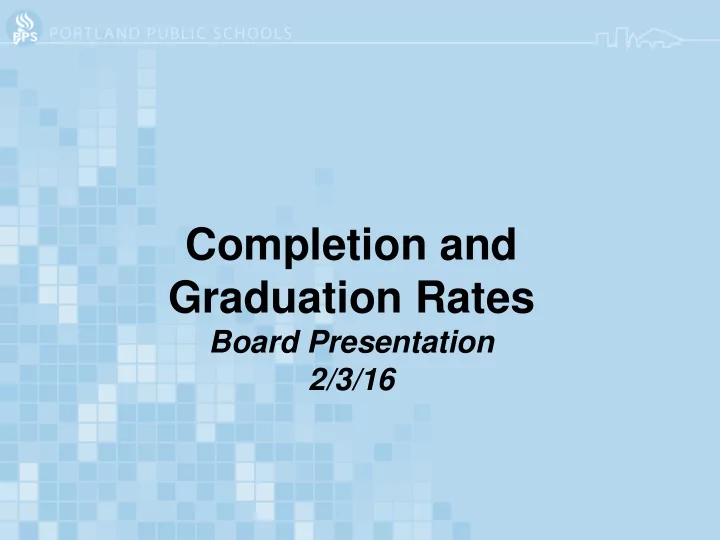

Completion and Graduation Rates Board Presentation 2/3/16
4- Year Cohort Graduation Rate Definition In 2008-09, the state began tracking graduation rates using the cohort graduation rate method Follows a class of students through four years of high school and measures the percentage that graduate on-time More rigorous than previous method Students earning GEDs or extended diplomas are not counted as graduates.
Cohort Method Added to cohort by transfer in (573 students) 9 th Grade Remained Final cohort 2011-12 enrolled (2649 2014-15 (3291 students) (3222 students) students) Removed from cohort by transfer out, etc… (642 students)
Definitions: 4 Year Completion Included in completer rate are students who…. graduated or earned a GED or Earned an extended or adult high school diploma In 2014, the GED revamped to be more rigorous and align with common core state standards
4-Year Cohort Graduation rates over time 74% 70% 67% 63% 62% 55% 53% 2008-9 2009-10 2010-11 2011-12 2012-13 2013-14 2014-15
Graduation & Completion 100% Rates 90% 82% 81% 80% 79% 80% 77% 76% 75% 74% 73% 73% 72% 70% 70% 67% 63% 62% 60% 50% 40% 30% 20% 10% 0% 2010-11 2011-12 2012-13 2013-14 2014-15 4 Year Graduation 4 Year Completion 5 Year Completion
Graduation Rate: Comparison to Oregon 80 % 73.82 75 72 73.71 68.66 70 68.44 67.65 66.38 70 66 65 66.91 63.09 62.27 60 Oregon 55 55.00 PPS 53 50 45 40 35 30 2008-9 2009-10 2010-11 2011-12 2012-13 2013-14 2014-15
4-Year Cohort Rate: Race/Ethnicity 100% 88% 90% 80% 77% 74% 69% 70% 67% 66% 65% 60% 55% 2010-11 51% 49% 2011-12 50% 44% 2012-13 40% 2013-14 2014-15 30% 20% 10% 0% Amer Indian Asian Black Hispanic Pacific White /Ala Nat Islander
4 Year Cohort Rates – 2014-15 n= 24 All Males 70% All Females 77% American Indian/ Alaska Native Male 45% n = 38 Native Hawaiian /Pacific Islander Male 50% n = 12 Hispanic /Latino Male 57% n = 272 American Indian/ Alaska Native Female 58% n = 26 Black/ African American Female 65% n = 198 Black/ African American Male 66% n = 204 Multi-Racial Male 71% n = 102 Hispanic /Latino Female 71% n = 250 White Male 71% n = 887 Multi-Racial Female 72% n = 111 NativeHawaiian/Pacific Islander Fmale 76% n = 21 White Female 79% n = 845 Asian Male 84% n = 153 Asian Female 91% n = 160 n=152 0% 20% 40% 60% 80% 100%
Graduation rates: other groups 2014-15 2010-11 % point gain since Graduation Rate Graduation Rate 2010-11* Economically 65% 57% +8% Disadvantaged Limited English 60% 42% +18% Proficiency (Emerging Bi-lingual) Special Education 49% 31% +18% TAG 91% 88% +3% Females 77% 68% +9% Males 70% 57% +13% 10 * 2010-11 marked the first year of High School System Design
4 Yr. Cohort Graduation Rates by School 2014-15 Graduation % point gain since rate 2010-11* Benson 88% +2.4% Cleveland +5.6% 85% Franklin 88% +16.7% Grant 89% +6.8% Jefferson 80% +25.7% Lincoln 93% +3.9% Madison 74% +10.5% Roosevelt 62% +8.7% Wilson 91% +12.9 Total (above) 85% +11% 11 * 2010-11 marked the first year of High School System Design
Other Highlights • Black/white graduation gap closed at Benson, Madison, and Roosevelt • Hispanic/white graduation gap closed at Benson, Franklin, Grant, Lincoln, and Wilson • Racially historically underserved male students increased rate by 7.3 percentage points from previous year
Graduation Rate Gap Closure Grad Rates for Historically Underserved Race students vs Not Historically Underserved Race students over time 80% 78% 74% 75% 13 73% percentage Not Historically 68% point 70% Underserved 67% difference Race Grad Rate 65% 65% 65% 19 percentage 60% point Historically difference Underserved 55% Race Grad Rate 56% 55% 52% 50% 52% 45% 46% 40% 2009-10 2010-11 2011-12 2012-13 2013-14 2014-15
Late Joiners 9 th Grade Joiners Late Joiners Graduation Rate Graduation Rate 2013-14 41% 77% 2014-15 47% (n = 573) 79% • “Late Joiners” are those students who join PPS after the 9 th grade • These students are disproportionately students of color • Racially Historically Underserved Late Joiners graduated at higher rates than White Late Joiners (49% vs. 46%)
Unassigned Students • 291 “unassigned” students • Graduated at a rate of 11% • Attended a CBO or special program • Vast majority have not attended a PPS comprehensive or focus option school • 23% or 66 of them entered PPS in their “senior year” or in 2014-15 • If all had these students had graduated, PPS could increase its graduation rate by 6% • More research needed to better understand who these students are
Who are unassigned students? 75 continued 46 GED on 137 33 dropped graduated out 291 Students
Key Strategies • Focusing on keeping 9 th graders on track – Ninth Grade Counts summer program – Freshmen academies – College and Career Exploration (CCE) course that is in every high school • Increased access to rigor – Examples include: Franklin High School’s Advanced Scholars program, Madison’s Senator Scholars and Jefferson’s Middle College program • Career technical education (CTE) – PPS has increased its state-approved CTE programs – from 19 in 2011-12 to over 50 today.
Key Strategies • Reconnection Center – Team of outreach workers connect with students who have left school and reconnect them to school – Door knocking campaign • Eight period schedule – 8 period day to preserve elective offerings for students, including CTE, credit recovery, AVID, etc… – This schedule, along with improved funding, led to an increase the number of students taking an eight period schedule. • Credit recovery – Credit recovery programs such as Summer Scholars where students who need just a few credits to get on track to graduate get that extra support. – Partnership with TriMet to expand free transit for Summer Scholars
Recommend
More recommend